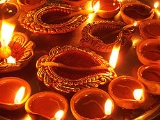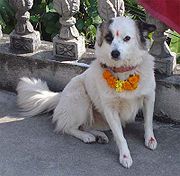
Tihar
Encyclopedia
Tihar is a five-day Nepal
ese festival celebrated in late autumn, which comes soon after Dashain. Two of these days incorporates the Hindu
festival Deepavali, where one day is celebrated for goddess Laxmi and the other one is celebrated to worship brothers for their long life. However, all ethnic groups celebrate this festival. The festival is celebrated from Trayodashi of Kartik Krishna to Katrik Shukla Dwitiya every year.The name Tihar means the festival of lights, where many candles are lit both inside and outside the houses to make it bright at night. The five-day festival is considered to be of great importance as it shows reverence to not just the humans and the Gods, but also to the animals like crow, cow and dog, who maintain an intense relationship with the humans.
 The second day is called "Kukur Puja
The second day is called "Kukur Puja
" or "Khicha Puja" ("worship of the dogs") by the Newar
s. Dog
, which is believed to be messenger of Lord Yamaraj
, the god of death, is worshiped once a year on this day. People offer garlands, teeka
and delicious food to the dogs, and acknowledge the cherished relationship between humans and the dogs.
This day is also observed as Narak Chaturdashi
.
In the evening Laxmi, the goddess of wealth is thanked for all the benefits that were bestowed on the families by lighting oil lamps or candles on doorways and windows to welcome prosperity and well being. At night the girls enjoy dancing and visiting all the houses of the village with many musical instruments playing a historical game called bhailini(vailini) all night long. They collect money from all the houses by singing and dancing and share the sweets and money amongst themselves.
perform Gobardhan Puja, which is worship towards Cowdung. Cowdung is seen as very useful in Nepal, as in the olden days it was used for everything from light at night (Methane
) to polish for the mud floors of traditional houses. The Newar community on the night of this day do Mha: Puja, or Worship of Self. Because this period is also the beginning of Nepal Sambat
, or the new year of Nepalese especially commemorated by Newars, it ensures prosperity for the new year.
The third and fourth day of Tihar is especially famous for Deusi and Bhailo, light and fireworks. Deusi and Bhailo
are the songs which have only been sung on those Tihar days. Social workers, young and children visit local homes to sing these songs, and in return the home owners give them money, fruit, rice and bread (Selroti, a special type of bread made by rice flour and sugar). The Deusi is mostly sung by the boys while the Bhailo
is sung by the girls.
" on foreheads of brothers, to ensure long life, and thank them for the protection they give. When the sisters give the "Tika
", the brothers give gifts or money in return. A special garland is made for the brothers out of a flower that wilts after a couple of months, symbolizing the sister's prayer for her brother's long life.
Category:Nepalese culture
Category:Festivals in Nepal
Category:Hindu festivals
ne:तिहार
Nepal
Nepal , officially the Federal Democratic Republic of Nepal, is a landlocked sovereign state located in South Asia. It is located in the Himalayas and bordered to the north by the People's Republic of China, and to the south, east, and west by the Republic of India...
ese festival celebrated in late autumn, which comes soon after Dashain. Two of these days incorporates the Hindu
Hindu
Hindu refers to an identity associated with the philosophical, religious and cultural systems that are indigenous to the Indian subcontinent. As used in the Constitution of India, the word "Hindu" is also attributed to all persons professing any Indian religion...
festival Deepavali, where one day is celebrated for goddess Laxmi and the other one is celebrated to worship brothers for their long life. However, all ethnic groups celebrate this festival. The festival is celebrated from Trayodashi of Kartik Krishna to Katrik Shukla Dwitiya every year.The name Tihar means the festival of lights, where many candles are lit both inside and outside the houses to make it bright at night. The five-day festival is considered to be of great importance as it shows reverence to not just the humans and the Gods, but also to the animals like crow, cow and dog, who maintain an intense relationship with the humans.
Kag Puja
The first day of the festival is called Kag Puja or Kag Parva - Worship of Crows. The crows are worshipped by offerings of sweets and dishes on the roof of the houses. The cawing of the crows symbolises sadness and grief in the Hindu mythology, so the devotees offer the crows food to avert grief and deaths in their homes.Tihar in Nepal and Diwali in India represent the divine attachment between Human and other animals and birds in our nature. To strengthen the worship of nature, all these rituals are introduced in Hinduism.Kukur Puja

Puja
Pūjā or alternative transliteration Pooja, is a religious ritual performed by Hindus as an offering to various deities, distinguished persons, or special guests...
" or "Khicha Puja" ("worship of the dogs") by the Newar
Newar
The Newa , Newār or Newāl) are the indigenous people and the creators of the historical civilization of Nepal's Kathmandu Valley. The valley and surrounding territory have been known from ancient times as Nepal Mandala, its limits ever changing through history.Newas have lived in the Kathmandu...
s. Dog
Dog
The domestic dog is a domesticated form of the gray wolf, a member of the Canidae family of the order Carnivora. The term is used for both feral and pet varieties. The dog may have been the first animal to be domesticated, and has been the most widely kept working, hunting, and companion animal in...
, which is believed to be messenger of Lord Yamaraj
Yama (Hinduism)
Yama is the lord of death in Hinduism, first recorded in the Vedas. Yama belongs to an early stratum of Indo-Iranian theology. In Vedic tradition Yama was considered to have been the first mortal who died and espied the way to the celestial abodes, thus in virtue of precedence he became the ruler...
, the god of death, is worshiped once a year on this day. People offer garlands, teeka
Tilaka
200px|thumb|right|Indian woman with tilaka and [[Bindi |bindi]]In Hinduism, the tilaka or tika or tilak is a mark worn on the forehead and other parts of the body...
and delicious food to the dogs, and acknowledge the cherished relationship between humans and the dogs.
This day is also observed as Narak Chaturdashi
Naraka Chaturdashi
Naraka Chaturdashi is a Hindu festival, which falls on the second day of the festival of Diwali.Kali means Dark and Chaudas - Fourteenth. Thus, celebrated on the 14th day of the dark half of Āshwin month, Kali Chaudas is the day allotted to the worship of Maha-Kali or Shakti and is believed that...
.
Gai Puja and Laxmi Puja
On the morning of the third day is Gai Puja - the cow is sign of prosperity and wealth. In ancient times people benefitted a lot from the cow like its milk, dung even its urine was used for kind of purification. Thus on this day people showed their gratefulness to the cow by garlanding and feeding the cow with the best grass. Houses are cleaned and the doorways and windows are decorated with garlands made of marigolds and chrysanthemums.In the evening Laxmi, the goddess of wealth is thanked for all the benefits that were bestowed on the families by lighting oil lamps or candles on doorways and windows to welcome prosperity and well being. At night the girls enjoy dancing and visiting all the houses of the village with many musical instruments playing a historical game called bhailini(vailini) all night long. They collect money from all the houses by singing and dancing and share the sweets and money amongst themselves.
Gobhardan Puja and Mha: Puja
On the fourth day of Tihar, there are three different known pujas, depending on the people's specific cultural background. Most perform Goru Puja, or Worship of Oxen. People who follow KrishnaKrishna
Krishna is a central figure of Hinduism and is traditionally attributed the authorship of the Bhagavad Gita. He is the supreme Being and considered in some monotheistic traditions as an Avatar of Vishnu...
perform Gobardhan Puja, which is worship towards Cowdung. Cowdung is seen as very useful in Nepal, as in the olden days it was used for everything from light at night (Methane
Methane
Methane is a chemical compound with the chemical formula . It is the simplest alkane, the principal component of natural gas, and probably the most abundant organic compound on earth. The relative abundance of methane makes it an attractive fuel...
) to polish for the mud floors of traditional houses. The Newar community on the night of this day do Mha: Puja, or Worship of Self. Because this period is also the beginning of Nepal Sambat
Nepal Sambat
Nepal Sambat is the national lunar calendar of Nepal. It was used throughout Medieval Nepal, and into early modern Nepal, until Chandra Sumsher decided to remove it in BS 1960. It was started in 880 AD during the reign of King Raghav Dev to commemorate the payment of all the debts of Nepalese...
, or the new year of Nepalese especially commemorated by Newars, it ensures prosperity for the new year.
The third and fourth day of Tihar is especially famous for Deusi and Bhailo, light and fireworks. Deusi and Bhailo
Bhailo
Bhailo and Deusi Re are song that is sung during the festival of light "Tihar" in Nepalese culture. Children and teenagerssing the song and dance as they go to various homes in their community, collecting money and food and giving blessings for prosperity.Bhailo is generally sung by Boys,while...
are the songs which have only been sung on those Tihar days. Social workers, young and children visit local homes to sing these songs, and in return the home owners give them money, fruit, rice and bread (Selroti, a special type of bread made by rice flour and sugar). The Deusi is mostly sung by the boys while the Bhailo
Bhailo
Bhailo and Deusi Re are song that is sung during the festival of light "Tihar" in Nepalese culture. Children and teenagerssing the song and dance as they go to various homes in their community, collecting money and food and giving blessings for prosperity.Bhailo is generally sung by Boys,while...
is sung by the girls.
Bhai Tika
The fifth and last day of Tihar is Bhai Tika, a day where sisters put "tikaTilaka
200px|thumb|right|Indian woman with tilaka and [[Bindi |bindi]]In Hinduism, the tilaka or tika or tilak is a mark worn on the forehead and other parts of the body...
" on foreheads of brothers, to ensure long life, and thank them for the protection they give. When the sisters give the "Tika
Tika
Tika can refer to:* Tilaka, the Nepalese name for 'tika'* Theravada commentaries* Peter, Albanian variation of a nickname for Petrika* Crown Prince, a title in certain Indian monarchies* A place in Abkhazia* A place on Saturn's satellite Rhea...
", the brothers give gifts or money in return. A special garland is made for the brothers out of a flower that wilts after a couple of months, symbolizing the sister's prayer for her brother's long life.
External links
Category:Nepalese culture
Category:Festivals in Nepal
Category:Hindu festivals
ne:तिहार

